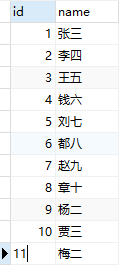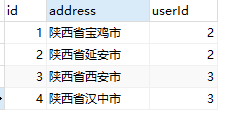前言
pageHelper是一款优秀的Mybatis分页插件,在项目中可以非常便利的使用,使开发效率得到很大的提升,但不支持一对多结果映射的分页查询,所以在平时的使用时,对于一对多分页会出现分页错误,这篇文章主要对pageHelper分页错误进行重现以及提出解决方案。分析
mybatis进行一对多查询时,映射文件(mapper.xml)中的sql语句中使用的左连接,pageHelper会自动对这条左连接sql语句进行select count(0)的处理,并把结果作为分页结构的记录总数,然后自动将limit拼接到sql语句末尾进行分页,由于左连接查询时,连接条件on条件不唯一(即一对多)时,结果会产生笛卡尔积,所以经过pagehelper插件分页得到的记录总数和分页结果并不是预期的结果。数据准备
共两个表:user、address,用户id与收货地址表中userId对应。
用户表【user】:11条数据

收货地址信息表【address】:4条数据

数据结构
public class UserDto {
public int id;
public String name;
List<Address> addressList;
}预期结果
要求对数据进行分页(每页5条),获得用户信息,每个用户信息带出对应收货信息, 用户id为2和3的用户各有两条收货地址信息,其余没有。期望结果如下
{
"code": 200,
"message": "success",
"data": {
"pageNum": 1,
"pageSize": 5,
"pages": 3,
"size": 5,
"total": 11,
"data": [
{
"id": 1,
"name": "张三",
"addressList": []
},
{
"id": 2,
"name": "李四",
"addressList": [
{
"id": 1,
"address": "陕西省宝鸡市",
"userId": 2
},
{
"id": 2,
"address": "陕西省延安市",
"userId": 2
}
]
},
{
"id": 3,
"name": "王五",
"addressList": [
{
"id": 3,
"address": "陕西省西安市",
"userId": 3
},
{
"id": 4,
"address": "陕西省汉中市",
"userId": 3
}
]
},
{
"id": 4,
"name": "钱六",
"addressList": []
},
{
"id": 5,
"name": "刘七",
"addressList": []
}
]
}
}问题重现
mybatis映射文件
<resultMap id="list" type="UserDto">
<id property="id" column="id" />
<result property="name" column="name"/>
<collection property="addressList" ofType="Address">
<result property="address" column="address"/>
<result property="userId" column="userId"/>
</collection>
</resultMap>
<select id="findAll" resultMap="list" >
SELECT
a.*,b.address,b.userId
FROM user a
LEFT JOIN address b on a.id=b.userId
</select>然后我们使用pageHelper进行分页,并输出日志
SELECT count(0) FROM user a LEFT JOIN address b ON a.id = b.userId
Preparing: SELECT a.*,b.address,b.userId FROM user a LEFT JOIN address b on a.id=b.userId LIMIT ?
Parameters: 5(Integer)
Total: 5日志分析
第1行:进行数据总数的查询,作为数据的总条数total
第2-4行:进行分页结果的查询,查询出5条数据
从日志中可以看出
pageHelper插件拼接后的sql语句就不会输出正确的结果,更不会输出符合期望的结果
pageHelper插件分两步查询,第一步查询出记录总数,第二步查询出分页结果
解决方案
方案一 思路:先分页查询出user表数据,然后在serviec服务层根据用户id查询对应的收货地址信息,并关联用户信息与收货信息。
service文件
public List<UserDto> findAll(){
List<UserDto> userList=userMapper.findUser();
userList.forEach((item)-> {
item.setAddressList(userMapper.findByUserId(item.id));
});
return userList;
}mybatis映射文件
<select id="findUser" resultType="UserDto">
SELECT * FROM user
</select>
<select id="findByUserId" parameterType="integer" resultType="Address">
SELECT * FROM address where userId=#{userId}
</select>方案二 思路:使用mybatis的嵌套子查询
<resultMap id="getList" type="UserDto">
<id property="id" column="id" />
<result property="name" column="name"/>
<collection property="addressList" ofType="Address" javaType="List" column="{userId=id}" select="getValueById" >
<id property="id" column="id" />
<result property="address" column="address"/>
<result property="userId" column="userId"/>
</collection>
</resultMap>
<!-- 主查询 -->
<select id="findAll" resultMap="getList">
select * from user
</select>
<!-- 子查询 -->
<select id="getValueById" resultType="Address" >
select a.* from address a where a.userId=#{userId}
</select>与嵌套映射结构的resultMap格式基本一致,一对多查询采用的依旧是collection,区别在于collection中多了select与column属性,select用于加载子查询映射语句的id,它会从column属性指定的列中检索数据,作为参数传递给目标select语句即子查询。
缺点:这种方式虽然可以解决pagehelper一对多分页的问题,但在大型数据表与数据集上性能表现不佳,即产生'1+N'问题。
输出以下sql日志:首先通过主查询语句获得主表的数据总量作为分页的total,第二步通过limit获得前5条分页数据(就是‘1’),第三步将第二步获得结果作为参数通过子查询获得地址表的信息(就是‘N’)
Preparing: SELECT count(0) FROM user
Parameters:
Total: 1
Preparing: select * from user LIMIT ?
Parameters: 5(Integer)
Preparing: select a.* from address a where a.userId=?
Parameters: 1(Integer)
Total: 0
Preparing: select a.* from address a where a.userId=?
Parameters: 2(Integer)
Total: 2
Preparing: select a.* from address a where a.userId=?
Parameters: 3(Integer)
Total: 2
Preparing: select a.* from address a where a.userId=?
Parameters: 4(Integer)
Total: 0
Preparing: select a.* from address a where a.userId=?
Parameters: 5(Integer)
Total: 0方案三 思路:弃用pageHelper插件,自定义分页查询,先对主表(user)进行分页,并把分页结果作为虚拟表与副表(address)进行左连接查询
<resultMap id="list" type="UserDto">
<id property="id" column="id" />
<result property="name" column="name"/>
<collection property="addressList" ofType="Address">
<result property="address" column="address"/>
<result property="userId" column="userId"/>
</collection>
</resultMap>
<select id="findAll" resultMap="list" parameterType="integer">
SELECT
a.*,
b.address,
b.userId
FROM
( SELECT * FROM user LIMIT #{size} ) a
LEFT JOIN address b ON a.id = b.userid
</select>







